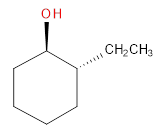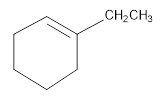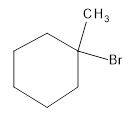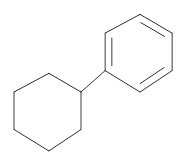
Concept explainers
(a)
Interpretation:
A method has to be suggested to prepare the following compound using cyclohexene as starting material.

Concept introduction:
Suzuki reaction:
A reaction that couples an aryl halide or vinyl halide using an Organoborane reagent.
Heck reaction:
A reaction that breaks the double bond of
Organoborane compound:
An alkyl–organoboron compound, an alkenyl–Organoboron compound, or an aryl –Organoboron compound:
Coupling reaction:
A reaction that joins two groups with a carbon-carbon single bond.
(b)
Interpretation:
A method has to be suggested to prepare the following compound using cyclohexene as starting material.

Concept introduction:
Suzuki reaction:
A reaction that couples an aryl halide or vinyl halide with an Organoboron reagent.
Heck reaction:
A reaction that breaks the double bond of alkene and then joins the fragments.
Organoborane compound:
An alkyl–organoboron compound, an alkenyl–Organoboron compound, or an aryl –Organoboron compound:
Coupling reaction:
A reaction that joins two groups with a carbon-carbon bond.
(c)
Interpretation:
A method has to be suggested to prepare the following compound using cyclohexene as starting material.

Concept introduction:
Suzuki reaction:
A reaction that couples an aryl halide or vinyl halide with an Organoboron reagent.
Heck reaction:
A reaction that breaks the double bond of an alkene and then joins the fragments.
Organoborane compound:
An alkyl–organoboron compound, an alkenyl –Organoboron compound, or an aryl–Organoboron compound:
Coupling reaction:
A reaction that joins two groups with a carbon-carbon bond.
(d)
Interpretation:
A method has to be suggested to prepare the following compound using cyclohexene as starting material.

Concept introduction:
Suzuki reaction:
A reaction that couples an aryl halide or vinyl halide with an Organoboron reagent.
Heck reaction:
A reaction that breaks the double bond of an alkene and then joins the fragments.
Organoborane compound:
An alkyl–organoboron compound, an alkenyl–Organoboron compound, or an aryl–Organoboron compound:
Coupling reaction:
A reaction that joins two groups with a carbon-carbon bond.
Want to see the full answer?
Check out a sample textbook solution
Chapter 11 Solutions
Student's Study Guide and Solutions Manual for Organic Chemistry
- You are a Quality Manager for a very well-known food ingredient company that produces umami powder, and you are responsible for setting specification limits. The net weight (in grams) of bags of unami powder is monitored by taking samples of six bags on an hourly basis during production. The label on every bag reports a contents of 1KG umami powder. The process mean is μ = 1012 g, and when the process is properly adjusted, it varies with σ = 11 g. QUESTION: Using all the available information, set the upper and lower specification limits.arrow_forward43) 10.00 ml of vinegar (active ingredient is acetic acid) is titrated to the endpoint using 19.32 ml of 0.250 M sodium hydroxide. What is the molarity of acetic acid in the vinegar? YOU MUST SHOW YOUR WORK. NOTE: MA x VA = MB x VBarrow_forward424 Repon Sheet Rates of Chemical Reactions : Rate and Order of 1,0, Deception B. Effect of Temperature BATH TEMPERATURE 35'c Yol of Oh نام Time 485 Buret rend ing(n) 12 194 16. 6 18 20 10 22 24 14 115 95 14738 2158235 8:26 CMS 40148 Total volume of 0, collected Barometric pressure 770-572 ml mm Hg Vapor pressure of water at bath temperature (see Appendix L) 42.2 Slope Compared with the rate found for solution 1, there is Using the ideal gas law, calculate the moles of O; collected (show calculations) times faster 10 Based on the moles of O, evolved, calculate the molar concentration of the original 3% 1,0, solution (sho calculations)arrow_forward
- Steps and explanations pleasearrow_forwardUse diagram to answer the following: 1.Is the overall rxn endo- or exothermic. Explain briefly your answer____________________2. How many steps in this mechanism?_____________3. Which is the rate determining step? Explain briefly your answer____________________4. Identify (circle and label) the reactants,the products and intermediate (Is a Cation, Anion, or a Radical?) Please explain and provide full understanding.arrow_forwardDraw the entire mechanism and add Curved Arrows to show clearly how electrons areredistributed in the process. Please explain and provide steps clearly.arrow_forward
 Organic And Biological ChemistryChemistryISBN:9781305081079Author:STOKER, H. Stephen (howard Stephen)Publisher:Cengage Learning,
Organic And Biological ChemistryChemistryISBN:9781305081079Author:STOKER, H. Stephen (howard Stephen)Publisher:Cengage Learning, General, Organic, and Biological ChemistryChemistryISBN:9781285853918Author:H. Stephen StokerPublisher:Cengage Learning
General, Organic, and Biological ChemistryChemistryISBN:9781285853918Author:H. Stephen StokerPublisher:Cengage Learning Introduction to General, Organic and BiochemistryChemistryISBN:9781285869759Author:Frederick A. Bettelheim, William H. Brown, Mary K. Campbell, Shawn O. Farrell, Omar TorresPublisher:Cengage Learning
Introduction to General, Organic and BiochemistryChemistryISBN:9781285869759Author:Frederick A. Bettelheim, William H. Brown, Mary K. Campbell, Shawn O. Farrell, Omar TorresPublisher:Cengage Learning Chemistry: Principles and ReactionsChemistryISBN:9781305079373Author:William L. Masterton, Cecile N. HurleyPublisher:Cengage Learning
Chemistry: Principles and ReactionsChemistryISBN:9781305079373Author:William L. Masterton, Cecile N. HurleyPublisher:Cengage Learning
 Introductory Chemistry: A FoundationChemistryISBN:9781337399425Author:Steven S. Zumdahl, Donald J. DeCostePublisher:Cengage Learning
Introductory Chemistry: A FoundationChemistryISBN:9781337399425Author:Steven S. Zumdahl, Donald J. DeCostePublisher:Cengage Learning





